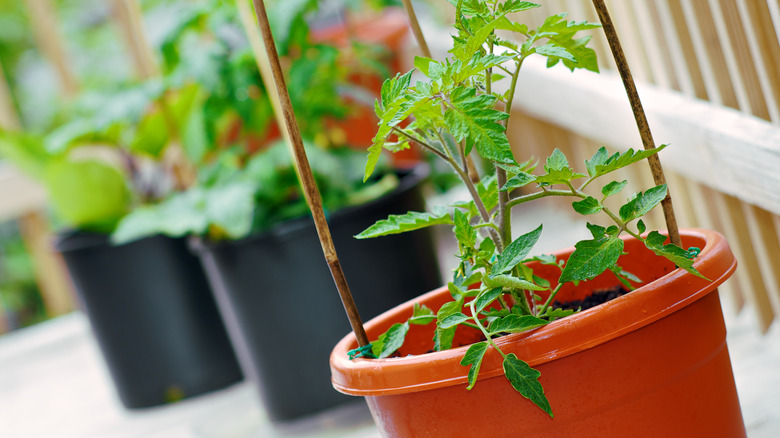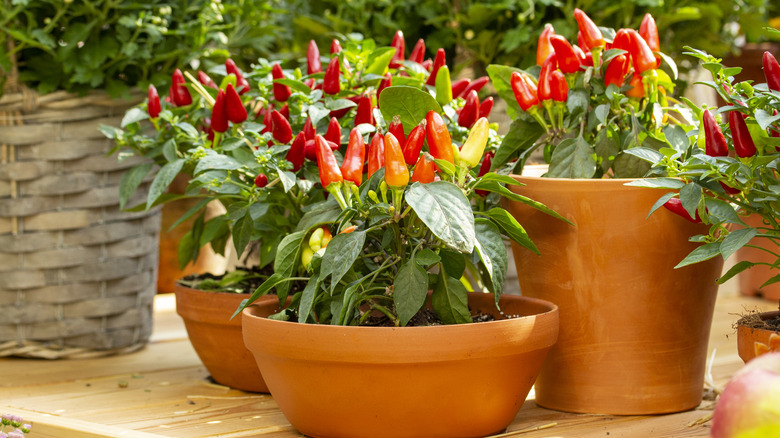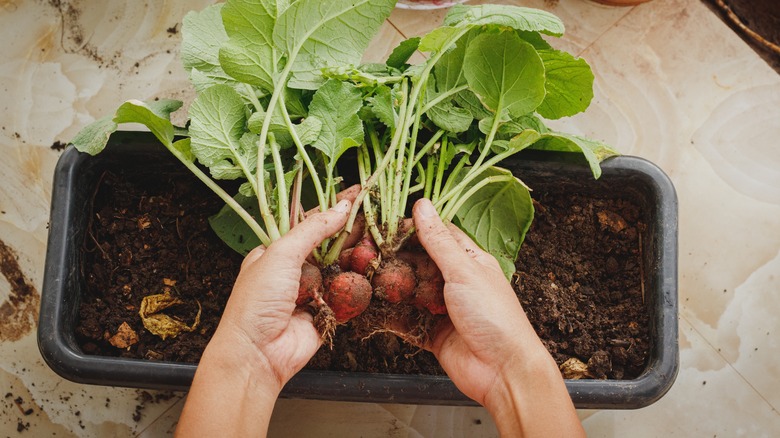These Vegetables Are Best When Grown In A Bucket
Bucket gardening has become a popular and practical solution for growing vegetables in limited spaces, such as balconies, patios, and small gardens. No longer are apartment dwellers prohibited from participating in home-growing herbs and vegetables with a lack of private garden space. Now, with the right selection of suitable vegetables, garden containers allow anyone to enjoy fresh, homegrown produce while maximizing space utilization. That being said, some veggies perform better in containers than others. Due to their small root systems, leafy vegetables like lettuce, spinach, arugula, and other greens grow well in modest-sized buckets. Additionally, nightshades like tomatoes, peppers, and eggplants benefit from the mobility of bucket containers as they can be easily rotated and moved in and out of the sun. Even certain varieties of vegetables are better suited for container gardening like cherry tomatoes rather than beefsteak.
Growers who choose bucket gardening will enjoy advantages over traditional gardens such as increased mobility and the ability to control soil conditions. In this way, bucket gardening is an ideal choice for many urban gardeners and those with limited outdoor areas. With proper care and attention, buckets can provide an optimal habitat for various vegetable plants to thrive and produce an abundant harvest.
Growing nightshades in buckets
Tomatoes are popular vegetables to cultivate in container gardens. Select compact bush types of tomatoes like Roma or Glacier for buckets. Vining tomatoes like Sun Gold or Cherokee Purple will not thrive as well. For a 5-gallon bucket, cultivate one plant and stabilize it with a stake. Take advantage of the mobility and move the tomatoes into full sun for at least six to eight hours.
Peppers are similar to tomatoes in that the bush varieties perform better in pots. Bell peppers and chili peppers are great for buckets since they like well-draining soil, which is more easily controlled in this environment. Be sure the bucket has holes in the bottom and consider adding an inch or two of pea gravel at the base to keep the roots of peppers from rotting.
Invest in a 5-gallon bucket for eggplants. They are heavy vegetables and need significant support, so a larger bucket will foster stronger root development. Eggplants enjoy full sun and moist soil, so be sure to water them well and place them in a sunny spot on the patio.
Potatoes are also nightshades and grow well in containers. They require a process called hilling to thrive. Fill the bottom of a container with about 4 inches of soil, place the seed potatoes in, then lightly cover with additional soil. As the plant grows above 6 inches, add more soil to the top, always making sure about one-third is covered.
Best root vegetables for buckets
In addition to nightshades, root vegetables also grow well in bucket containers. Short carrot varieties, for example, are specifically bred for container cultivation. Choose varieties like Thumbelina or Paris Market, which have small, round or cylindrical roots that are ideal for growing in limited spaces. Be sure the bucket is deep enough to accommodate the carrot's root length and use loose, well-draining soil to deter deformities. Regular watering and thinning of seedlings will promote healthy growth and ensure a bountiful harvest of sweet and crisp carrots.
Radishes are quick-growing root vegetables that are well-suited for bucket gardening as well. Like leafy greens, they have shallow root systems that can tolerate compact conditions. Radishes do best in loose soil with good drainage. Varieties like Cherry Belle or French Breakfast are commonly grown in containers due to their small size and rapid maturity. Sow the seeds directly into the bucket, ensuring proper spacing, and maintain consistent moisture for optimal growth.
Finally, beets are nutritious root vegetables that will flourish in buckets. Like carrots and radishes, they prefer loose and well-draining soil. Select beet varieties with smaller root sizes, such as Bull's Blood or Detroit Dark Red, which are adaptable for container growing. Adequate depth is essential for proper root development, so choose a deeper bucket or container. You should also be consistent with moisture levels to prevent the roots from becoming woody or bitter. Regularly thinning the seedlings allows each plant to grow, resulting in robust, sweet, and flavorful beets.


